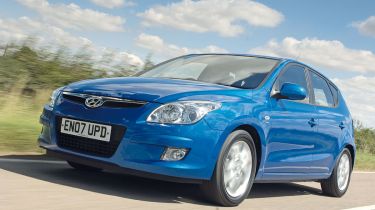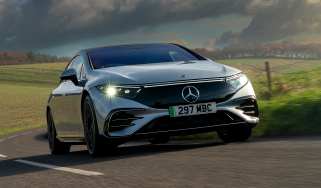Hyundai i30
Does Hyundai's C-segment competitor have what it takes to unseat its popular rivals?

Finally, Hyundai has a car that can compete in the affordable hatchback sector. With excellent standard kit, a compliant ride and measured, reassuring handling, there’s not much to criticise – even if the styling isn’t to your taste. We think it makes most sense in entry-level 1.4 Comfort trim, which is lavishly appointed and offers lots of pace, too. There is little reason to opt for the 1.6, which carries a £1,300 premium. Some of the materials used to clad the doors and dashboard could be better – but for the money, the i30 makes a lot of sense.
Forget the sporty Coupé, or even the top-selling Santa Fe 4x4. According to Hyundai, the i30 is the most important car it has ever launched in the UK.
Aimed at the Ford Focus and the Volkswagen Golf, the all-new family model will be the barometer by which the manufacturer’s progress and success will truly be judged.
Video: watch CarBuyer's video review of the Hyundai i30
[[{"type":"media","view_mode":"content_narrow","fid":"69217","attributes":{"alt":"","class":"media-image"}}]]
Sister brand Kia made a similar declaration when it introduced the Cee’d – a car which shares the same underpinnings and drivetrains. So, will the i30 follow in the successful footsteps of its counterpart?
It certainly has the style to suggest the firm is heading into uncharted ter-
ritory. Hyundai is taking design cues from premium brands such as Lexus and Audi in its bid to move upmarket. It has also launched a new naming strategy, with the range starting at i10 – for the Amica replacement – and moving up to i70, with special suffixes for estates, coupés and SUVs.
So what does the i30 offer? Well, it’s immediately clear that it’s a step forward from the Accent it replaces, and the shape catches the eye. The rounded nose and angular lights are smart, and mark it out from the Cee’d.
Look closely, however, and it’s very similar in certain areas – particularly the doors, bonnet and that upswept rear-quarter glass. The large tail-lights echo those from Mercedes’ A-Class, although their positioning gives the i30 a hint of the BMW 1-Series.
Overall, it doesn’t appear as sleek as the Cee’d. And the base 1.4 Comfort will get 15-inch wheels rather than the 16-inch alloys on our pre-production version. Either way, the i30 seems solidly built on the outside.
So it’s a shame the materials used inside feel so cheap. True, this is an entry-level variant, and so misses out on luxuries such as a leather steering wheel, but the plasticky finish on the gearlever is unforgivable.
The cabin layout is neat, if a little dull, while the blue-lit instrument and stereo displays help lift things. Equipment is good, too, with a CD player, six airbags, electric windows, air-con and a USB/MP3 port standard. Showroom models will also get steering wheel-mounted stereo controls.
On the road, the i30 is composed and reassuring, if short on thrills. Body control could be better and it moves round under braking, but the steering is nicely weighted, making for easy progress in town. It’s precise through corners, too. Yet the smooth, comfortable ride impresses the most, with potholes being dealt with superbly.
The 1.4-litre engine is also a major strength. It delivers only 108bhp, but feels urgent at low speeds and likes being revved. Although performance is nothing to write home about, it’s nippy in city centre traffic and quiet enough at motorway speeds.
At less than £11,000, the base i30 is also great value – especially with Hyundai’s five-year warranty. Ignoring the Cee’d, few rivals can compete in terms of equipment at this price.
Rival: focus 1.4 16v studio
Ford’s entry-level Focus offers a solid interior and is refined on the road. It’s competitively priced, although the i30 is better specified.



